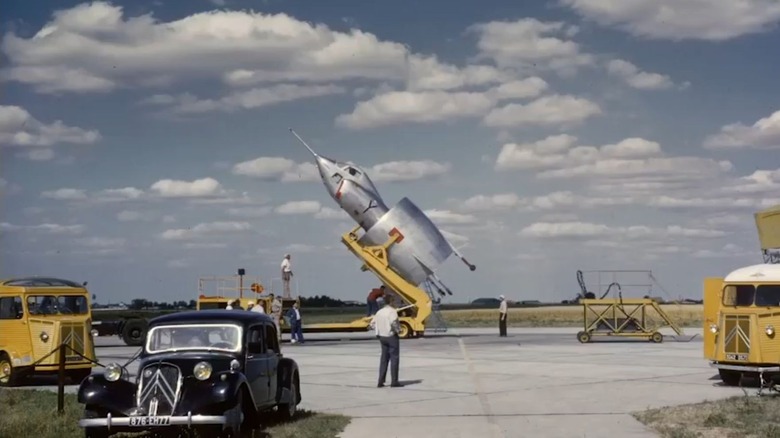The Futuristic French Plane Designed To Fly Without Wings
Since the dawn of man, we have gazed into the sky and yearned to fly. Even those with a minimum of aeronautical acumen know that to achieve flight, you need wings to generate lift to get a plane off the ground.
And what do planes need for that? Long runways. Runways are, by their very nature, problematic as they take up enormous swaths of land and are costly to build and maintain. Military runways, in particular, are targeted first in a war, the Smithsonian Magazine notes, because if you take out an enemy's runways, you've effectively eliminated its air force.
During the 1950s, aircraft engineers started thinking outside the box. If planes had more power, they might not need runaways at all. Thus began a wave of experimentation with early forms of Vertical Take-Off and Landing (VTOL) aircraft known as "tail-sitters," that, if proven successful, would basically do away with the need for runaways entirely since they could take off from virtually anywhere, per Mustard.
Acclaimed French aircraft engine builder SNECMA (Société Nationale d'Études et Construction de Moteurs d'Aviation, now Safran Aircraft Engines), using designs from Austrian engineer Helmut von Zborowski, began building a prototype plane that didn't use typical delta-shaped wings. In fact, the C.450 Coléoptère (the French word for "beetle") didn't have wings at all, according to Smithsonian Magazine). To paraphrase Mel Brooks ("Blazing Saddles"), who paraphrased John Huston ("The Treasure of the Sierra Madre") — "Wings? We don't need no stinking wings."
Tail-sitters are exactly what you imagine them to be — planes standing upright on their tales.
Spread your circular donut wing and fly?
Powered by an axial-flow turbojet engine, the Coléoptère had a 10.5-foot diameter ring-shaped "wing" that encircled the bottom half of the plane. SNECMA hoped to eventually make it a RAM jet by compressing the incoming air, mixing it with fuel, and lighting a fire that would send it well beyond MACH speeds, Mustard notes.
During take-offs and landings, thrust would be deflected using vanes housed in the engine's exhaust. Four small fins strategically placed around the "wing" would act as rudders to provide directional control while in flight. Retractable fins tucked inside the nose would deploy and help tilt the plane upright into "landing" mode.
An innovative swiveling cockpit seat allowed the pilot to remain in a locked and upright position based on the plane's alignment. Since these were the days before powerful computer simulations, human test pilots had to strap in and give these prototypes a go. It began real-world testing in April 1959, and serious problems sprung up almost immediately. Without a stabilizing wing, the plane spun while hovering in the vertical take-off stage. Sitting like astronauts on top of a rocket, pilots had difficulty seeing the ground. Lastly, without wings, which theoretically would allow it to glide to safety if the engines failed, the Coléoptère would be doomed according to Mustard.
On July 25, 1959, SNECMA tested the plane's ability to transition from vertical take-off into horizontal flight mode. It tilted too far, and the pilot couldn't regain control. He ejected to safety, but the Coléoptère was destroyed in the process. Funding for a second prototype never materialized, and the project was scrapped (via Mustard).
